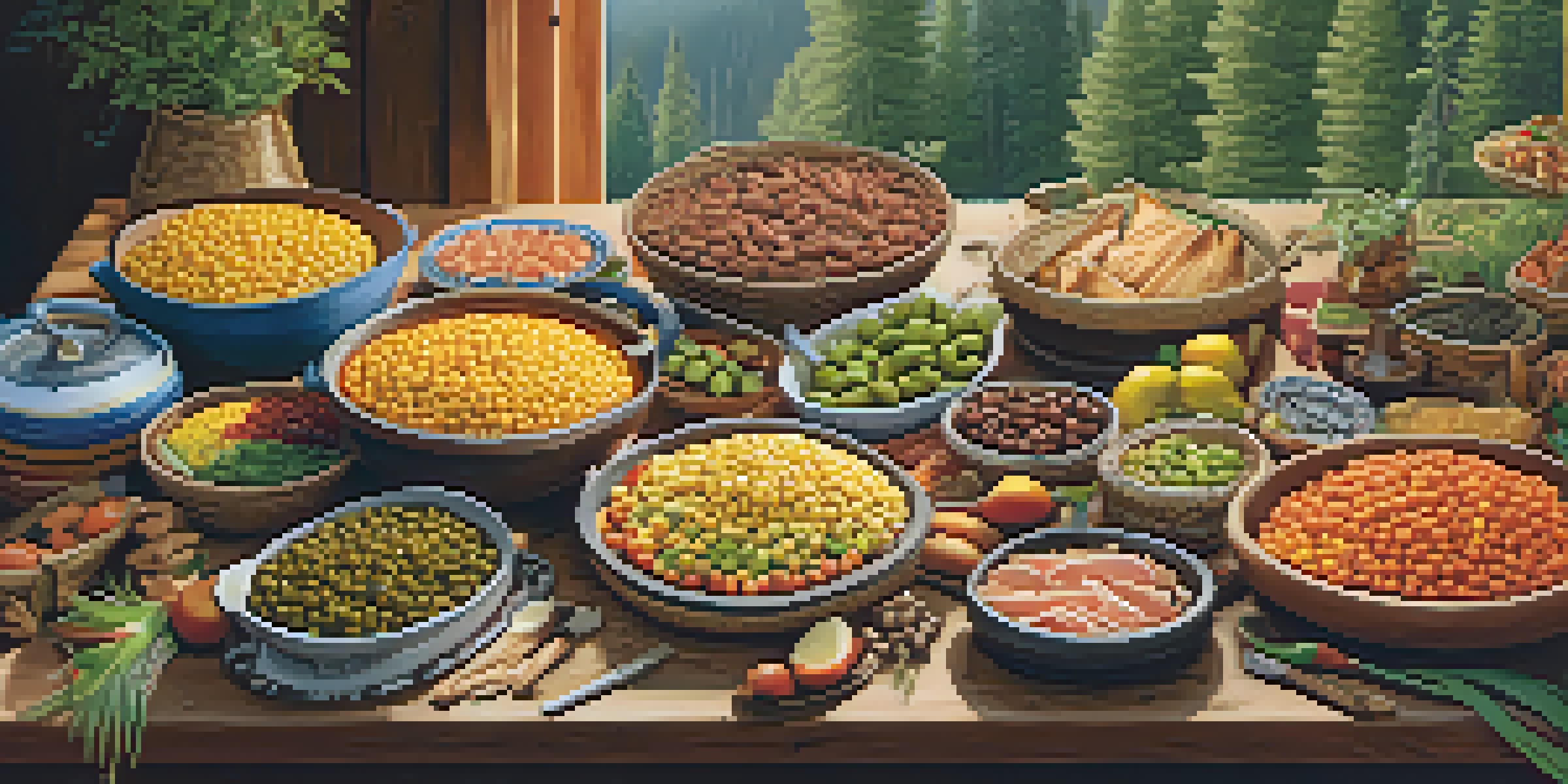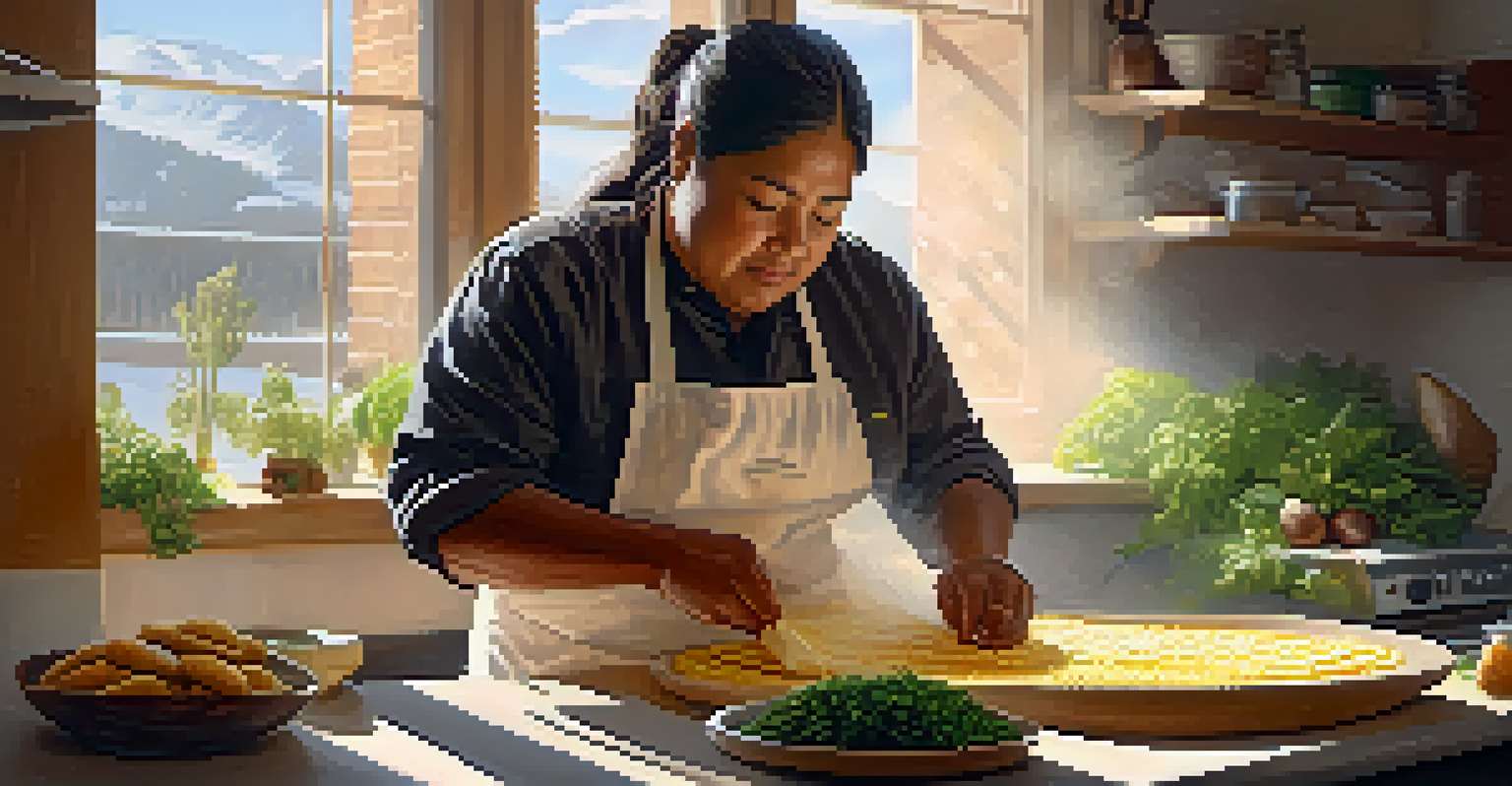Native American Cuisine: A Culinary Journey Through Culture

Understanding the Roots of Native American Cuisine
Native American cuisine is a rich tapestry woven from various cultural traditions, each reflecting a unique relationship with the land. This culinary style dates back thousands of years, rooted in the practices of indigenous peoples across North America. The use of local ingredients such as corn, beans, and squash—often referred to as the 'Three Sisters'—highlights the agricultural wisdom and sustainability of these communities.
Food is not just what we eat; it is our relationship with the land, the water, and each other.
In addition to plants, Native American diets included a variety of meats, fish, and wild game, showcasing the diverse ecosystems present in different regions. For example, tribes in the Pacific Northwest relied heavily on salmon, while those in the Great Plains hunted buffalo. This diversity illustrates how geography and environment shaped culinary practices, leading to distinctive regional dishes.
Understanding these roots is crucial for appreciating the depth of flavors and techniques that characterize Native American cuisine today. It's not just about the food—it's a reflection of a culture that honors tradition, spirituality, and community.
Key Ingredients in Native American Cooking
The cornerstone of Native American cuisine lies in its natural and locally sourced ingredients. Staples like corn, beans, and squash form the basis of many traditional dishes and are often combined in creative ways. For instance, 'succotash'—a mix of corn and beans—illustrates how these ingredients work together to provide nourishment and flavor.

Wild game and fish also play significant roles, with species varying by region. In addition to the aforementioned salmon and buffalo, other meats such as venison, rabbit, and various birds are common in different tribal diets. This reliance on local wildlife not only ensures freshness but also aligns with the values of respect and sustainability inherent in many Native cultures.
Cultural Depth of Native Cuisine
Native American cuisine reflects a deep connection to the land, showcasing traditional ingredients and cooking methods that honor cultural heritage.
Furthermore, herbs and spices like sage, juniper, and wild garlic enhance the flavors of these dishes, often carrying cultural significance as well. This emphasis on natural ingredients not only sustains the body but also connects the eater to the land and its history.
Traditional Techniques in Native American Cooking
Cooking methods in Native American cuisine are as varied as the tribes themselves, with techniques passed down through generations. Baking in earthen ovens, known as 'clay ovens' or 'pits', is a traditional method used by many tribes for cooking meats and plants. This time-honored approach not only infuses food with rich flavors but also symbolizes a connection to the earth.
To know food is to know culture; it is a way of connecting with the past, present, and future.
Another fascinating technique is the use of smoking to preserve meats and fish, a practice that has been essential for survival. For example, the preservation of salmon through smoking ensures that it can be enjoyed long after the fishing season has ended. This method reflects the resourcefulness and adaptability of Native American peoples.
Steaming, boiling, and roasting are also common methods, each contributing to the texture and taste of dishes. These traditional techniques not only create delicious meals but also foster a sense of community as families gather to prepare and share food together.
Celebrating Native American Food Through Festivals
Food plays a central role in many Native American festivals, which are often vibrant celebrations of culture, community, and heritage. Events like the Gathering of Nations Powwow showcase traditional foods alongside music, dance, and art, fostering a sense of unity among various tribes. These gatherings provide opportunities to share culinary traditions and stories, strengthening communal bonds.
Many tribes also hold seasonal feasts that mark important events, such as harvests or hunting seasons. These feasts not only celebrate the bounty of the land but also express gratitude and respect for the resources provided. For instance, a corn harvest festival may feature dishes made with freshly harvested corn, highlighting the importance of this staple in their diets.
Importance of Food Sovereignty
Food sovereignty emphasizes the right to culturally appropriate food and is crucial for restoring traditional practices and addressing health issues in Native communities.
Incorporating traditional recipes into these festivals allows for the preservation of cultural heritage while also inviting younger generations to engage in their culinary roots. This celebration of food serves as a reminder of the resilience and richness of Native American cultures.
Modern Adaptations of Native American Cuisine
As with any culinary tradition, Native American cuisine is evolving, adapting to contemporary tastes while retaining its core values. Many chefs are now incorporating traditional ingredients into modern dishes, creating a fusion that honors the past while appealing to today's palates. For example, a traditional fry bread might be reimagined as a taco shell, blending Native flavors with popular cuisine.
In urban areas, Native American food trucks and restaurants are gaining popularity, showcasing indigenous ingredients and dishes in a modern context. These establishments not only serve delicious meals but also educate patrons about Native cultures and histories, fostering a greater appreciation for this rich culinary heritage.
This blending of old and new is a testament to the resilience of Native American cultures, demonstrating that food can be both a means of survival and a form of artistic expression. By embracing innovation, Native cuisine continues to thrive and inspire.
The Importance of Food Sovereignty
Food sovereignty is a critical concept within Native American communities, emphasizing the right to healthy and culturally appropriate food produced through ecologically sound methods. Many tribes are working to reclaim traditional food systems that were disrupted by colonization and industrialization. This movement is not just about food—it's about culture, identity, and self-determination.
Restoring traditional agriculture practices, such as growing indigenous crops and using sustainable farming techniques, plays a vital role in this movement. By doing so, tribes can revive their culinary heritage while also addressing issues related to health and nutrition within their communities. This is particularly important in combating the high rates of diet-related illnesses that many Native populations face today.
Celebration of Culinary Heritage
Festivals and communal gatherings highlight the role of food in Native American culture, preserving traditions while fostering community bonds.
Food sovereignty also fosters a deeper connection to the land and reinforces the idea that food is a shared resource, rather than a commodity. This shift towards more sustainable practices not only honors ancestral traditions but also empowers communities to take control of their food systems.
Preserving Native American Culinary Heritage
Preservation of Native American culinary traditions is crucial in ensuring that these practices and flavors are passed down to future generations. Many tribes are actively documenting traditional recipes and cooking methods as a way to keep their heritage alive. Community cookbooks and culinary workshops are excellent resources for sharing knowledge and skills.
Additionally, educational programs that focus on indigenous food systems help to raise awareness about the importance of traditional food practices. By teaching young people about the significance of these foods, communities can instill pride in their culinary heritage and encourage participation in food preparation and celebration.

Moreover, as interest in sustainable and local eating grows, the unique flavors and dishes of Native American cuisine are gaining recognition beyond tribal boundaries. This newfound appreciation can help foster a greater understanding and respect for the culture, ensuring that these culinary traditions continue to thrive in a modern world.